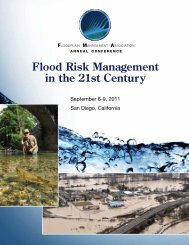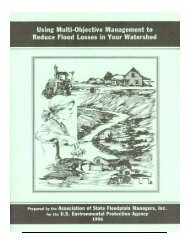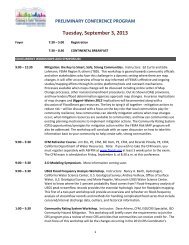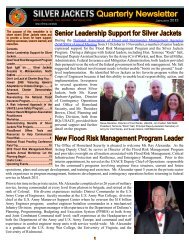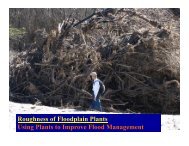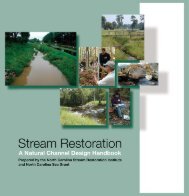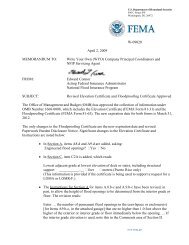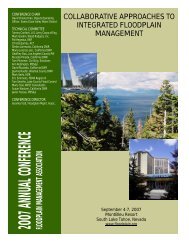San Francisco Bay Area Study - Floodplain Management Association
San Francisco Bay Area Study - Floodplain Management Association
San Francisco Bay Area Study - Floodplain Management Association
- No tags were found...
Create successful ePaper yourself
Turn your PDF publications into a flip-book with our unique Google optimized e-Paper software.
<strong>San</strong> <strong>Francisco</strong> <strong>Bay</strong> <strong>Area</strong>Coastal <strong>Study</strong>Inaugural <strong>Bay</strong> <strong>Area</strong> FMA LuncheonMarch 13, 2013
California Coastal Analysis andMapping ProjectTwo Companion Large-Scale Efforts:• <strong>San</strong> <strong>Francisco</strong> <strong>Bay</strong> <strong>Area</strong> Coastal <strong>Study</strong>• Open Pacific Coast <strong>Study</strong>Re-study flood riskalong the open coastand inland bays of allCalifornia coastalcountiesRe-map the elevationand inland extent ofwave-induced coastalfloodingwww.r9coastal.org2
Risk MAPVisionTo deliver quality data thatincreases public awarenessand leads to action thatreduces risk to life andpropertyObjective (Coastal)To provide updated flood hazarddata for 100% of the populated U.S.coast3
Comprehensive & Collaborative• Covers 100% of the <strong>San</strong><strong>Francisco</strong> <strong>Bay</strong> coastalcommunities in 9 counties• Leverages latest 2010 NOAAand USGS LiDARtopographic data• Regional hydrodynamic,storm surge, and wavemodeling• Detailed onshore coastalhazard analysis• Outreach, coordination and collaboration with numerouspartners, stakeholders, and other studies4
ScheduleCounty2012 2013 2014 2015 2016Marin<strong>San</strong> <strong>Francisco</strong>Contra CostaSonomaSolanoNapaAlameda<strong>San</strong> Mateo<strong>San</strong>ta Clara<strong>Floodplain</strong> Mapping Preliminary Map Production Post‐Preliminary ProcessFlood Risk Review MeetingPreliminary FIRM Meeting5
Overall Schedule Snapshot• Marin – 1 stFlood RiskReview (FRR)Meeting Jan 17 th• <strong>San</strong> <strong>Francisco</strong> –FRR planned forApril/May• Contra Costa –FRR planned forAugust6
Overall Schedule Snapshot• Sonoma Countywrapping upcoastal analysisin April• Napa/Solanoanalysiscomplete byJuly7
Coastal <strong>Study</strong> ProcessDataAcquisitionRegionalModelingFieldReconTransectLayoutDetailedCoastalAnalysisWorkMapsFloodRiskReviewMtgSignificant Deliverable / Milestone9
<strong>Bay</strong>-Wide Regional ModelingSeas Surge SwellSmall10Large
Overland Coastal Hazard Analyses• Transect-based analysis• Wave runup• Wave overtopping• Wave propagation overland• Transect locations anddensity based on:• Shoreline type andcharacteristics• Shoreline direction• Nearshore bathymetry• Wave dynamics• Land use and development11
<strong>Floodplain</strong> Mapping (Work Maps)12
Flood Risk ReviewMeeting
Flood Risk Review Meeting• Provide an overview of the National Flood InsuranceProgram (NFIP) and Risk MAP• Provide an overview of the <strong>San</strong> <strong>Francisco</strong> <strong>Bay</strong> <strong>Area</strong>Coastal <strong>Study</strong>• Discuss coastal study process and methodology• Review and discuss the draft Work Maps and theonline tool for review and comments• Discuss how the products can inform decisions toreduce flood risk• Learn how to communicate about flood risk usingthe products and datasets• Answer questions14
On-line Work Map Review Tool15
Tool Overview• Post draft Work Maps online at r9coastal.org forcommunity review• Accommodate community staff need to review databeyond the meeting timeframe• Reduce paper mapproducts from theworkflow – andreduce the potentialfor lost comments16
Comment Process• Users will be provided a unique login and password• Communities will have 30 days to review the WworkMaps• All comments will berecorded andarchived• Comments will betaken intoconsideration as themapping entersproduction17
Outreach andCommunication
Nudging Out of the Comfort Zone20
Mill Valley, Marin County21
Bel Marin Keys, Marin County22
Flood Risk Awareness Surveys• Nationwide, Research-based• FEMA surveyed local officials in 2010 to:• Provide a baseline of flood riskawareness• Inform national outreach andcommunity engagement activities• FEMA conducted a second survey in 2011 to trackprogress toward its awareness goals:• Public awareness and understanding of risk management• Local official awareness of flood risk within Risk MAP projectareas23
Survey Says…• The following tools would make it easier for localofficials to share flood risk information with thepublic:• Information to add to community websites• Publications for building owners on reducing risk• Customizable letters or brochures• Media materials such as draft press releases24
Tools, Templates and Products• Tools & Resources –• FEMA website - library• www.r9coastal.org• Mapping, LOMC guidancedocs, flood insurance,floodplain management• 1-877-FEMA-MAP• <strong>Study</strong> Brochures• Coastal Beat• Templates –• Community Outreach PlanTemplate• Press release• Open House Materials• Non-regulatory Products –• Changes Since Last FIRM25
Hazard Mitigation Planning• What is Hazard Mitigation?• Any sustained action taken to reduce or eliminate longtermrisk to human life and property from hazards• Why are Hazard Mitigation Plans Important?• Foundation for a long-term strategy to reduce disasterlosses and break the cycle of disaster damage,reconstruction, and repeat damage• Provides a framework for risk-based decision makinginvolving stakeholders and the public.26
Hazard Mitigation Planning• How is Hazard Mitigation Planning relevant to SF BAC<strong>Study</strong>?• Results of the <strong>Study</strong> (FIRMs) enable communities to “IdentifyRisk,” the first step in the Risk MAP Life Cycle• Mitigation Planning provides the framework to carry out theremaining 3 steps in the Risk MAP Life Cycle using <strong>Study</strong>results• Assess Risk and Vulnerability using Coastal Flood HazardInformation/Data• Communicate Risk through public involvement – increaseseducation and awareness of Hazards and Risks• Mitigate Risks by identifying actions and aligning them withother community objectives27
Hazard Mitigation Planning ProcessCommunities with Lapsedor No Plans1. Organize Resources2. Assess Risks3. Develop Mitigation PlanCommunities withApproved and AdoptedPlans4. Implement Plan andMonitor Progress28
Hazard Mitigation Planning –Resources• FEMA (http://www.fema.gov/multi-hazard-mitigation-planning)• Laws, Regulations, Guidance, Policies• How-To Guides• Mitigation Grant Funding Programs• Training• Cal EMA (http://hazardmitigation.calema.ca.gov/)• State Hazard Mitigation Plan, other Plans, andGuidance• Grant Information• Hazard Data and Information• Maps, GIS Data, Analysis Tools(MyPlan/MyHazards)• ABAG (http://quake.abag.ca.gov/resilience/)• 2010 Hazard Mitigation Plan and ParticipatingJurisdictions’ Annexes• Hazard Maps and Information• Housing and Infrastructure Losses Data29
Comprehensive & CollaborativeSF <strong>Bay</strong> <strong>Area</strong> Coastal <strong>Study</strong>provides:• Regional data set forunderstanding andcommunicating flood risk• Input to the Hazard MitigationPlanning Process• Foundation for coastal resilienceplanning• Stepping stone for sea level risevulnerability and riskassessments and adaptationplanning30
Questions & Answers




